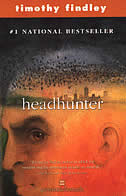
Timothy Findley's novel Headhunter (Harper Perennial, 1993) is a very good example of what Jeoffrey Bull (writing in the Journal of Canadian Studies) calls "diagnostic fiction". Headhunter (which won the City of Toronto Book Award) describes a near-future dystopian Toronto afflicted by cultural and political depravity and a frightening bird flu known as sturnusemia. Deliberately appropriating symbolism and characters from Joseph Conrad's Heart of Darkness (and rather powerfully reminiscent of Camus' The Plague and Thomas Mann's Death in Venice) Findley's novel diagnoses not individual patients but a whole city. Prescient, isn't it?
A decade after Headhunter was published, Toronto was rocked by a contained outbreak of SARS (Severe Acute Respiratory Syndrome). In 2006, the city awaits the first dread trickles of avian influenza virus A -- also known as bird flu -- believed to be the leading candidate for the world's next influenza pandemic. Politicians, the medical establishment, the media, and ordinary citizens in Toronto and elsewhere nervously consider the options for prevention, containment, and treatment -- and contemplate the likelihood of corruption and chaos in the scramble to decide who will be treated, quarantined, or abandoned to the ravages of disease. Acknowledging the truism that more people are likely to die of terror, exposure, and chaos in the aftermath of a disaster than from the source of the disaster itself, perhaps now is a good time to revisit Findley's novel, to read into its vision of things to come.
In Findley's Toronto, the city's psychological and moral malaise is symbolized by Dr. Rupert Kurtz, Director of the Parkin Institute of Psychiatric Research. Setting himself up as the god-head of treatment, Kurtz simultaneously diagnoses and encourages the "death-urge" sweeping the city. It is something he finds aesthetically pleasing, and he draws power from it, unleashing the darkest urges of his patients and joining in them.
Meanwhile, starlings, the alleged carriers of sturnusemia (an AIDS-like virus), are being gassed by squads in city parks, but the birds are not the biggest threat to the city. Rather, Kurtz is the greatest danger, a reality recognized only by one of the city's gently insane, a former librarian who inadvertently unleashes fictional characters from books, including some (like Kurtz) who harm; others (like Susannah Moodie) who advise; and one (Dr. Charles Marlow) who might stand against Kurtz. But Kurtz's army is willingly seduced, low-lidded with power and depravity. And as Kurtz remarks of them near the end,
Every single one of them was persuaded from within. .... My only interest lay in bringing two desiring factions together. I melded them. I made them one. ... I gave them what they wanted. ... I gave them permission.And the plague takes them all, the members of the Club of Men, their young victims, and Kurtz too. And at the end of the novel, in the city's desolate light, the D-Squads continue to gas and burn the city's birds, while the living mad go on in their gentle way.
*
This is not to say, of course, that Toronto under plague conditions would be as dark as Findley narrates it. Indeed, the City's response to the 2003 SARS crisis is generally agreed to have been exemplary. And Toronto has responded to conditions of contagion in the past, during outbreaks of tuberculosis, Spanish flu, and cholera.
But we live in a time when public trust is at a low ebb, while the media almost eagerly report projected shortages of flu drugs and squabbles over treatment priority lists. And who can say you have never looked into the eyes of a professional or politician and seen only darkness there?
Sources
Bull, Jeoffrey S., 1998. Giving the Sickness a Name: Reading Timothy Findley's Headhunter and Walker Percy's The Thanatos Syndrome as Diagnostic Fictions. Journal of Canadian Studies, 33(4): 153-165.
Cude, Wilf, 1996. Truth Slips In: Timothy Findley's Doors of Fiction. The Antigonish Review, 105. Available electronically at http://www.antigonishreview.com/bi-105/105-cude.html
Findley, Timothy, 1993. Headhunter. Toronto: Harper Perennial Canada.
No comments:
Post a Comment